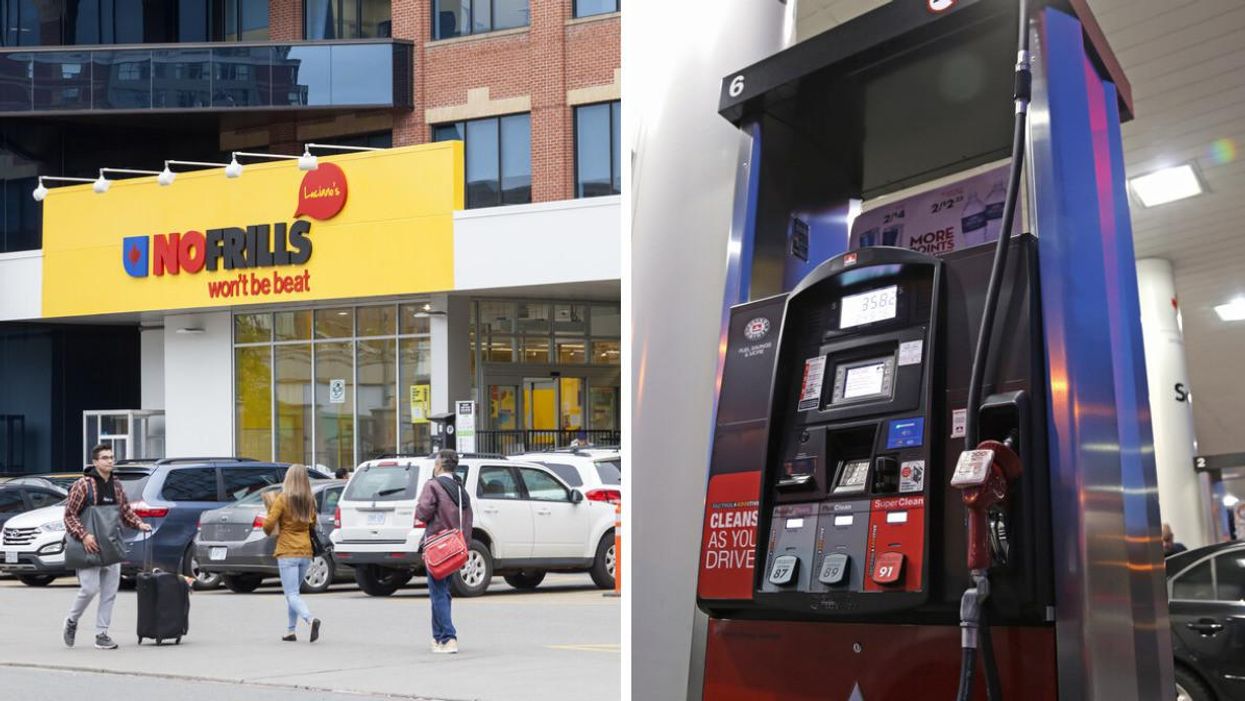Canada's Inflation Rate Is The Highest It's Been Since 1983 & Here's What You're Paying More For
RIP your budget. 🥴

A No Frills grocery store. Right: A gas station pump.
Canada's inflation rate is now the highest it's been in nearly 40 years, with a bunch of essentials getting more and more expensive.
The May 2022 Consumer Price Index, released by Statistics Canada, laid out inflation's effects on everyday goods such as food, fuel and housing.
Per the index, Consumer inflation in Canada rose by 7.7% across the board last month compared to the same time last year.
This makes it the largest increase since January 1983, beating out the previous month's year-over of 6.8%.
The cost of fuel continues to be one of the forces driving inflation up, with the cost of gasoline rising by 48% since May 2021.
Along with this, the cost of energy, in general, rose 35%, with the price of crude causing things like fuel oil and other fuels to grow by a massive 95.1%.
The price increase of fuel and energy continues to be so high because of the Russian invasion of Ukraine and the uncertainty it has brought to the supply of crude oil. The high demand for travel around the world has also contributed to the growth.
For those thinking of their supermarket budget, a few staples have surged once again.
The price of edible fats and oils has increased by 30% — their largest on record.
Fresh vegetables also saw their costs climb by 10.3%, mostly driven by the rising value of peppers, onions and carrots.
Meat and fish also went up by 9% and 11.7%, respectively, with meat actually slowing down from the previous month's rate of 10.1%.
In terms of keeping a roof over your head, the amount of money Canadians have to put toward shelter rose by 7.4% — the same rate we saw in April.
Luxuries like hotel stays are more expensive as well due to the aforementioned demand for travel.
The rate for a stay at a hotel has gone up by 40.2%, with the biggest increases felt in Ontario (56.8%), B.C. (43.2%) and Nova Scotia (41.8%).
According to the report, this demand for travel is a direct result of easing COVID-19 pandemic restrictions.
One of the more intriguing climbs in cost was for furniture, rising 15.8% since last year.
This is suspected to be a result of inflated shipping charges and a new tariff that was introduced on upholstered furniture imported from Vietnam and China.
Regionally, the province that has seen the most local inflation is Prince Edward Island, which has an inflation rate of 11.1%. This is driven by higher gasoline and fuel prices in the island province.
While inflation continues to grow, the Bank of Canada attempts to curb its expansion by, in turn, raising the interest rate.
A higher interest rate makes the borrowing of money more expensive, which hopefully would "cool" the Canadian economy.
However, these measures to tamp down inflation have led to affordability concerns for Canadian homeowners affected by the interest rises.
- Inflation Has Gone Up Again & It's The Biggest Increase Of The Cost ... ›
- Canada's Interest Rate Is Increasing & Here's What That Means For ... ›
- The Bank Of Canada's Increase Of Interest Rates Could Cause A Recession & It's Happened Before - Narcity ›
- A Poll Says Inflation Is Ruining Canadians' Summer Plans & The Top Money Drainer Is Just Sad - Narcity ›
